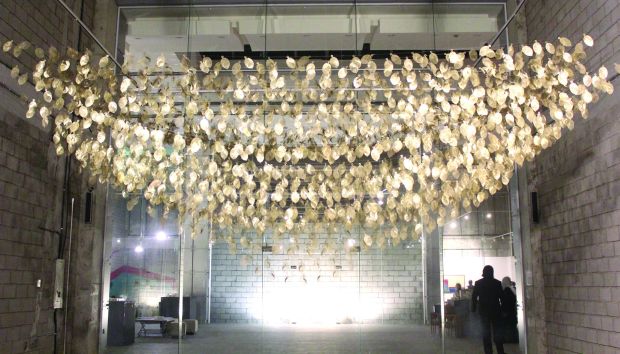Jeddah, Asharq Al-Awsat—Saudi Arabian artist Manal Al-Dowayan is causing a stir in the Arab art world with her family trees. These are family trees with a difference: a series of matrilineal ones engraved on brass leaves and brought together at the Jeddah Art Week last week to form a physical tree. Al-Dowayan’s Tree of Guardians was a major hit at Jeddah Art Week, receiving both popular and critical acclaim. Tree of Guardians can currently be seen as part of the ‘21,39’ Jeddah Arts Initiative launched by the Saudi Arts Council.
Al-Dowayan describes herself as a “conceptual artist at the forefront of the global contemporary art scene.” She was born and raised in Saudi Arabia’s oil-rich Eastern Province and worked as the Creative Director of the Saudi Arabian oil company for 10 years before becoming a full-time artist.
Asharq Al-Awsat met with Al-Dowayan in Jeddah in one of the public workshops held prior to the exhibit, where visitors could come and contribute to the production of one of the brass leaves that later made it onto the Tree of Guardians. With all the additions, by the end of the exhibition that artwork resembled more of a forest of matrilineal family trees.
The workshop began with Al-Dowayan distributing pens and paper to the participants. She told them: “Start with your name, and then your mother’s name, and then her mother’s name, and keep going as far back as possible.”
AlDowayan told participants: “This is a family tree but from a female perspective. Men have put forward a vision of Saudi Arabia’s social history that is influenced by external factors, such as political and social relations. But women have a different history . . . and we are trying to promote Saudi customs and traditions from women’s perspective.”
She added: “These family trees will also include stories and songs from childhood, and family anecdotes handed down from mothers and grandmothers. All of this draws up an image of the customs and traditions of society Saudi from the woman’s perspective.”
The women at the workshop each began by drawing up their own family trees. One woman told Asharq Al-Awsat: “If the purpose of the project is to preserve the names of our forebears and for the future generations not to forget their own family history, then why are we leaving out the names of our fathers and grandfathers?” This is one point of view, but Al-Dowayan responds that the exercise is important to shed light on Saudi women’s female heritage, which is often overlooked.
“It is the women who are forgotten. We remember the names of our grandfathers and even those who came before, because this is the name that is recorded in our official documents. As for our female forebears, these are not recorded in this manner, and so are forgotten,” she said.
Al-Dowayan reveals that her own matrilineal family tree only goes back five generations, and the family trees of the women attending the workshop range from those that do not extend beyond the grandmother, to those that go back much further.
One participant tells Asharq Al-Awsat: “We should not only be recording the key names&8212;the mother, the grandmother, and so on—but also the names of aunts, nieces and female cousins, because all of this is important. If the objective is to preserve the names of women in a family, then every name is important and worth recording.”
But Al-Dowayan’s website confirms that “women—mothers, grandmothers, aunts and older sisters—became both the repositories and the transmitters of traditional culture, ethics and ideals. Nursery rhymes, poems, stories, riddles, parables, fables: these became the information packet through which traditional identities, attitudes and values were actively transmitted to subsequent generations. This installation is not a sterile exercise in history. Rather, it exists at this moment in time, capturing the views and experiences of a rising generation of young women who, even as they reflect on their own families histories, serve as the next generations of incubators of knowledge, culture and authenticity.”

